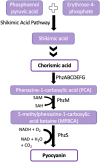A biomedical perspective of pyocyanin from Pseudomonas aeruginosa: its applications and challenges
- PMID: 38341389
- PMCID: PMC10858844
- DOI: 10.1007/s11274-024-03889-0
A biomedical perspective of pyocyanin from Pseudomonas aeruginosa: its applications and challenges
Abstract
Pyocyanin is a bioactive pigment produced by Pseudomonas aeruginosa. It is an important virulence factor that plays a critical role in P. aeruginosa infections as a redox-active secondary metabolite and a quorum sensing (QS) signaling molecule. Pyocyanin production from chorismic acid requires the involvement of two homologous operons, phz1 and phz2, which are activated by QS regulatory proteins. Pyocyanin inhibits the proliferation of bacterial, fungal, and mammalian cells by inducing oxidative stress due to which it acts as a potent antibacterial, antifungal, and anticancer agent. Its potential role as a neuroprotectant needs further exploration. However, pyocyanin exacerbates the damaging effects of nosocomial infections caused by P. aeruginosa in immunocompromised individuals. Further, cystic fibrosis (CF) patients are highly susceptible to persistent P. aeruginosa infections in the respiratory system. The bacterial cells form colonies and three interconnected QS networks-pqs, las, and rhl-get activated, thus stimulating the cells to produce pyocyanin which exacerbates pulmonary complications. As an opportunistic pathogen, P. aeruginosa produces pyocyanin to impede the recovery of injuries like burn wounds through its anti-proliferative activity. Moreover, pyocyanin plays a vital role in compounding P. aeruginosa infections by promoting biofilm formation. This review begins with a brief description of the characteristics of pyocyanin, its activity, and the different aspects of its production including its biosynthesis, the role of QS, and the effect of environmental factors. It then goes on to explore the potential applications of pyocyanin as a biotherapeutic molecule while also highlighting the biomedical challenges and limitations that it presents.
Keywords: Antibacterial; Anticancer; Antifungal; Neuroprotective; Pseudomonas aeruginosa; Pyocyanin.
© 2024. The Author(s).
Conflict of interest statement
The authors declare no conflict of interest with regard to the content of this review article. The authors have no relevant financial or non-financial interests to disclose.
Figures














Similar articles
-
Differential Regulation of the Phenazine Biosynthetic Operons by Quorum Sensing in Pseudomonas aeruginosa PAO1-N.Front Cell Infect Microbiol. 2018 Jul 23;8:252. doi: 10.3389/fcimb.2018.00252. eCollection 2018. Front Cell Infect Microbiol. 2018. PMID: 30083519 Free PMC article.
-
The histidine kinase NahK regulates pyocyanin production through the PQS system.J Bacteriol. 2024 Jan 25;206(1):e0027623. doi: 10.1128/jb.00276-23. Epub 2024 Jan 3. J Bacteriol. 2024. PMID: 38169296 Free PMC article.
-
The Small RNA AmiL Regulates Quorum Sensing-Mediated Virulence in Pseudomonas aeruginosa PAO1.Microbiol Spectr. 2022 Apr 27;10(2):e0221121. doi: 10.1128/spectrum.02211-21. Epub 2022 Mar 9. Microbiol Spectr. 2022. PMID: 35262393 Free PMC article.
-
Modulation of pulmonary immune functions by the Pseudomonas aeruginosa secondary metabolite pyocyanin.Front Immunol. 2025 Mar 24;16:1550724. doi: 10.3389/fimmu.2025.1550724. eCollection 2025. Front Immunol. 2025. PMID: 40196115 Free PMC article. Review.
-
The role of quorum sensing in chronic cystic fibrosis Pseudomonas aeruginosa infections.FEMS Microbiol Lett. 2009 Jan;290(1):1-9. doi: 10.1111/j.1574-6968.2008.01394.x. Epub 2008 Oct 29. FEMS Microbiol Lett. 2009. PMID: 19016870 Review.
Cited by
-
Green Biosynthesis of Bimetallic Copper Oxide-Selenium Nanoparticles Using Leaf Extract of Lagenaria Siceraria: Antibacterial, Anti-Virulence Activities Against Multidrug-Resistant Pseudomonas Aeruginosa.Int J Nanomedicine. 2025 Apr 14;20:4705-4727. doi: 10.2147/IJN.S497494. eCollection 2025. Int J Nanomedicine. 2025. PMID: 40255676 Free PMC article.
-
A plasmid-encoded inactive toxin-antitoxin system MtvT/MtvA regulates plasmid conjugative transfer and bacterial virulence in Pseudomonas aeruginosa.Nucleic Acids Res. 2025 Feb 8;53(4):gkaf075. doi: 10.1093/nar/gkaf075. Nucleic Acids Res. 2025. PMID: 39950345 Free PMC article.
-
Traditional Chinese Medicine Monomer Bakuchiol Attenuates the Pathogenicity of Pseudomonas aeruginosa via Targeting PqsR.Int J Mol Sci. 2024 Dec 30;26(1):243. doi: 10.3390/ijms26010243. Int J Mol Sci. 2024. PMID: 39796099 Free PMC article.
-
An insight into pyocyanin: production, characterization, and evaluation of its in vitro antibacterial, antifungal, antibiofilm and in vivo anti-schistosomal potency.BMC Microbiol. 2025 Aug 23;25(1):532. doi: 10.1186/s12866-025-04248-1. BMC Microbiol. 2025. PMID: 40847290 Free PMC article.
-
Lavandula dentata leaves as potential natural antibiofilm agents against Pseudomonas aeruginosa.Sci Rep. 2025 Mar 12;15(1):8540. doi: 10.1038/s41598-025-88824-5. Sci Rep. 2025. PMID: 40074746 Free PMC article.
References
-
- Abdelaziz AA, Kamer AMA, Al-Monofy KB, Al-Madboly LA. A purified and lyophilized Pseudomonas aeruginosa derived pyocyanin induces promising apoptotic and necrotic activities against MCF-7 human breast adenocarcinoma. Microb Cell Fact. 2022;21:262. doi: 10.1186/s12934-022-01988-x. - DOI - PMC - PubMed
-
- Abdul-Hussien ZR, Atia SS. Antimicrobial effect of pyocyanin extracted from Pseudomonas aeroginosa. Eur J Exp Biol. 2018;6:1–4.
Publication types
MeSH terms
Substances
LinkOut - more resources
Full Text Sources
Research Materials

